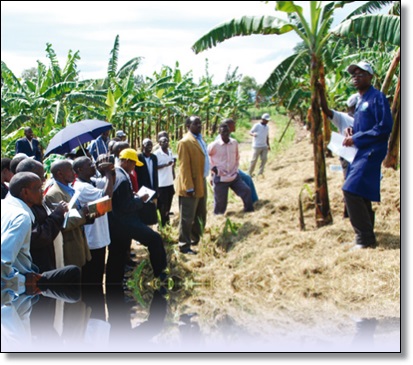Farmers Organisations Key in Corruption Fight

 |
| NAADS official talks to farmers P.Courtesy |
For the first time and away from the negative commentary I often read in the press, most farmers in Mityana and Mubende seem to like some government programs. Unlike in many parts of the country where farmers complain about the poor trunk and community access roads, in Mityana and Mubende, farmers are extremely thrilled with what the government has done as far as the road network in the region is concerned. Farmers assert that with improvement of the road network in the area, agricultural prices of their produce have more than doubled. But there is bad news too - farmers say that the government has done little on rural electrification. With no electricity in most parts of the area, value addition from their produce cannot be done. They need electricity to set up factories that can help to grind their maize grains to be able to sell at an improved fee. One farmer argues that it is heinous that due to intermittent electricity, farmers with chicken enterprise can’t make their own feeds and resort to expensive feeds from Kenya. The Rural Electrification Agency should look at this closely.
Farmers are also alarmed with the continued flow of counterfeit inputs in the market. These range from seeds to crop protection chemicals. The law that would help to combat counterfeits is weak. Farmers are confident that if the government can point out genuine traders who deal in quality and proven products, it would be a step towards agricultural transformation. The farmers have compelled their umbrella organisation, The Uganda National Farmers Federation (UNFFE) to provide them a list of genuine input dealers. It is urgent that UNFFE delivers on it.
The National Agriculture Advisory services (NAADS) which receives public funds on farmers’ behalf remains a big uphill elephant that farmers know about and like, but have limited knowledge of its detailed operations. Farmers do not know how much money is allocated to NAADs, when that money is released and what specifically that money is meant for. For example, the Auditor General’s report of 2008 reveals that only 37.1 per cent of the total money spent on NAADS may be considered as useful expenditure. Since the inception of the program in June 2006, it is estimated that a total of US$ 107 million had been spent on NAADS activities (Auditor General 2008). Issues of corruption and other financial irregularities in the implementation of NAADS programme are commonplace in the media. As such, some studies following quantitative approaches such as Benin et al. (2007), and qualitative approaches such as OPM (2005) and Scanagri (2005) provide insights into the glaring fault lines of the NAADS program. In particular, Benin et al. (2007) observed that although there is some positive effect of NAADS on adoption, no significant differences in yields were found between NAADS and non -NAADS farmers. Spending without results is a loss for farmers and Ugandan tax payers in general. But with the AfT/USAID GAPP intervention, farmers are now learning the skills and techniques of how to follow their money from Kampala, to Mityana and Mubende district local governments, up to the farm. With knowledge on budgeting and execution processes of NAADS program, farmers and their organisations will hold corrupt officials to account.
According to Morrison Rwakakamba, Chief Executive Officer Agency for Transformation (AFT), there is urgent need to build the capability of farmers to track NAADS funds and ensure that money reaches intended beneficiaries. NAADS must incorporate the governance, participation and performance principles which the GAPP project also seeks to promote. Critical to this endeavour is improving the agency of farmers as key actors in the implementation of this major government program.
Rwakakamba also says that Uganda which stands on 236,040 square miles, has a population of about 37 million people, a growth rate of 3.2 per cent and about 7 million households will most likely face a deepening land crisis if efficiency and appropriate technologies are not deployed on farms. Sunday Emmanuel Bushema, the Board Member of NAADS and UNFFE respectively argue that there is need to transcend the horizon, mechanise agriculture and carry out more research on the soils so that scientific methods of farming can be extensively used in order to curb the ever increasing food demands in the country. He also argues the case for regional farm schools and young farmers’ parks. This is a conversation that leaders at all levels in Uganda should take seriously.
By Gideon Shambire
Research Associate, Agency for Transformation
